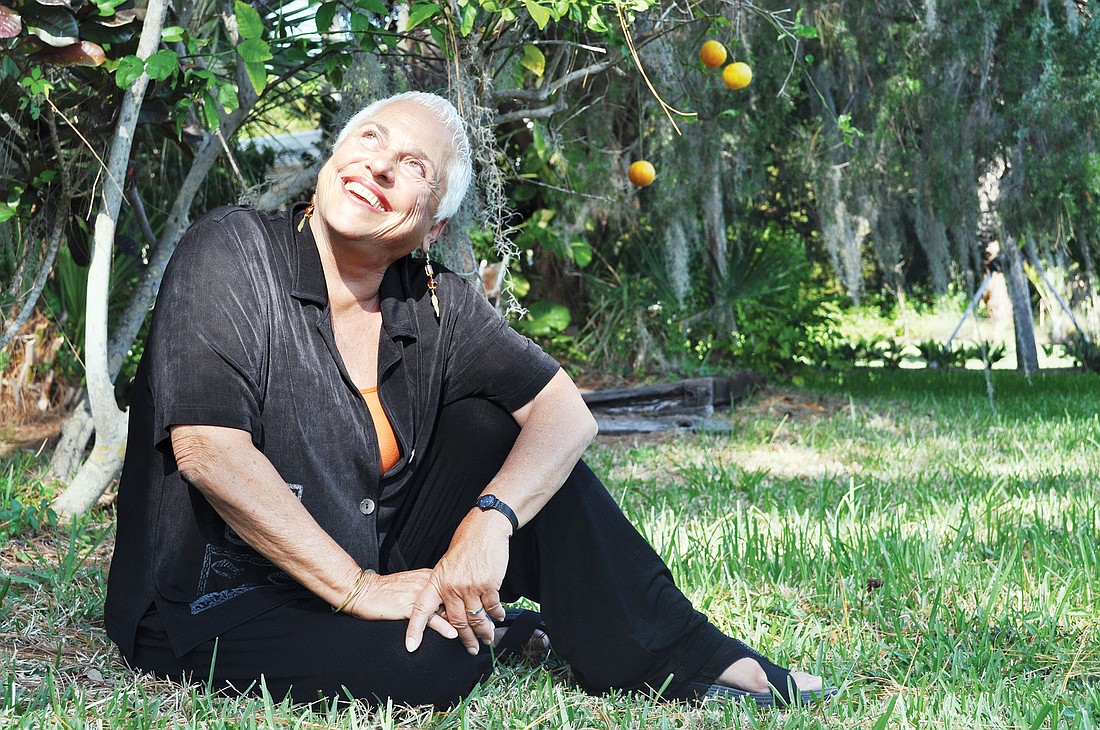- April 18, 2024
-
-
Loading

Loading

When Elizabeth Weil Bergmann says she dances alone in her living room, you believe her.
Her sun-drenched house in Sarasota’s quiet Oyster Bay neighborhood has an open floor plan with plenty of space to move, say, if one were to put on Schubert and twirl with reckless abandon.
Bergmann is exactly the kind of retired dance doyenne that you can picture twirling — not in a prima ballerina kind of way, but in a loose-limbed, interpretive dance kind of way.
She’s the picture of fluidity: dangling earrings, rayon pants, big smile and an unfussy crop of short, white hair.
“I thought I’d die on the dance floor,” says Bergmann, who retired this year from her post as dance director at Harvard University. “I still might. It just won’t be in Cambridge.”
A Juilliard graduate with a resumé that includes a 21-year professorship at the University of Michigan, Bergman joined the faculty of the Carreño Dance Festival in February.
She signed on hoping to impart her love of modern dance to up-and-coming performers.
“I’m on a mission,” she says. “So many kids trot off to these ballet schools, and outside of ‘Swan Lake’ and ‘Nutcracker,’ they don’t know much. I feel strongly that our young dancers need to learn everything there is to learn about dance. There are plenty of opportunities beyond just making a ballet company.”
Bergmann is sitting at a glass table, sipping an unsweetened iced tea, waxing nostalgic about her dance days in New York City — the late 1950s, a time ruled by Martha Graham, José Limón, Antony Tudor and Louis Horst, all of whom she studied under in her youth.
“It really was the golden age,” Bergmann says. “Of course, at the time I didn’t know it. That’s the thing with golden ages. You don’t know you’re living through them until years later.”
Hired in 2000 to helm Harvard’s fledging extracurricular dance program, Bergmann was practically a legend by the time she left the school, which was, she says, her objective.
Venerated as it is, Harvard is not exactly known for its dance program.
When Bergmann arrived on campus, a handful of no-credit dance classes were being taught out of a cramped basement studio buried at the end of a series of tunnels.
In just 11 years, she managed to build a dance center, expand the program to include a dense curriculum of credited courses and build a roster that included more than 800 student dancers.
“I wanted to see if I could put a chink in the staid bricks,” Bergmann says. “I didn’t think there were any dancers at Harvard, and, then, they just came out of the woodwork!”
Rising to let her cat in from outside, she glosses over the weight of her Ivy League accomplishments, leaving the rest of the story to be filled in by a quick Internet search.
A Harvard arts blog reveals that, in December, members of the Harvard-Radcliffe Modern Dance Company performed pieces of Bergmann’s choreography at a farewell dance concert.
In a post dedicated to the choreographer and teacher, former students expressed their gratitude for Bergmann’s vision and leadership.
“There is one person who is the heart and soul of the dance program,” states 2007 grad Sonia Todorova. “(And that’s) Liz Bergmann.”
A native of Evansville, Ind., Bergmann was 16 years old when her mother wrote a letter to then-New York Times dance critic John Martin inquiring about suitable outlets for her dance-crazed daughter.
“I came out of the womb dancing,” Bergmann jokes.
Aside from a handful of small schools that taught beginning tap and tumbling lessons, there weren’t many dance studios in Southern Indiana in the 1950s.
So Martin suggested sending Bergmann to Jacob’s Pillow Dance Festival, in Becket, Mass.
“It was nine weeks of non-stop dance,” Bergmann says. “I saw every performance and I went to every class. It changed my life.”
Two years later, she was accepted to The Juilliard School on the recommendation of a ballet teacher from Indiana University, who slipped the then-18-year-old dancer into the school on probation.
Five years later, she became the youngest faculty member at the University of Michigan, where she remained a professor in the department of dance until 1982.
“I learned at a young age that I’m a giver,” Bergmann says of her decision to pursue teaching over performing. “To have an impact on a person’s body right in front of you. Golly. It doesn’t get any better than that.”
She says she would have hung around New York for years hoping to get into a ballet company had she not been exposed to so many different options as a young dancer.
“I’d still be sitting through rehearsals, knitting wool tights and smoking,” she laughs. “How boring is that?”
BERGMANN ON HER CELEB PUPILS
Madonna (University of Michigan, 1977)
“She came to me as a freshman. She was a very slim, typical ballerina type. She was definitely going to make it as a dancer. There was no question about it. When we brought Pearl Lang in to make a work, she took Madonna under her wing, and as a result Madonna went to New York to dance with Martha Graham. As you know, things changed from there.”
Natalie Portman (Harvard, 2000)
“By the time she took my class she had already done ‘Star Wars’ and was a pretty big star. I’m almost embarrassed to admit it, but I didn’t recognize her. She’s very little and nondescript, and at Harvard she went by her birth name –– Natalie Hershlag. I was always apologizing for forgetting her name. Finally, one of the other students came up to me and asked, ‘Don’t you know who she is?’ I was so intimidated after that.”